Read the following text and answer the following questions on the basis of the same:
If we move into space and study the Earth's invisible magnetic field, it wouldn't really look like a bar magnet at all. Earth's magnetic field gets stretched out into a comet-like shape with a tail of magnetism that stretches millions of miles behind the earth, opposite to the Sun. The Sun has a wind of gas that pushes the earths field from the left to the right in the picture.
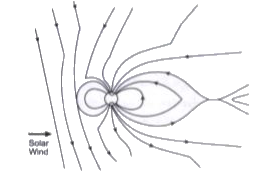
The core of the Earth is an electromagnet. Although the crust is solid, the core of the Earth is surrounded by a mixture of molten iron and nickle. The magnetic field of Earth is caused by currents of electricity that flow in the molten core. These currents are hundreds of miles wide and flow at thousands of miles per hour as the Earth rotates. The powerful magnetic field passes out through the core of the Earth, passes through the crust and enters space. This picture shows the solid inner core region (inner circle) surrounded by a molten outer core (the area between the two circles). The currents flow in the outer core, travel outwards through the rest of the earth's interior. If the Earth rotated faster, it would have a stronger magnetic field.
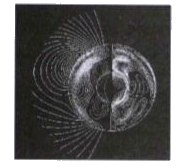
By the time the field has reached the surface of Earth, it has weakened a lot, but it is still strong enough to keep your compass needles pointed towards one of its poles. All magnets have two poles: a North Pole and a South Pole. The magnetic poles of earth are not fixed on the surface, but wander quite a bit. The pole in the Northern Hemisphere seems to be moving northwards in geographic latitude by about 10 kilometres per year by an average.
Earth's magnetic field may increase if:
A
it rotates on its axis faster.
B
its direction of rotation is changed.
C
it revolves round the Sun faster.
D
All of the above
Text Solution
The correct Answer is:A
If the Earth rotated faster, it would have a stronger magnetic field.
|
Similar Questions
Knowledge Check
Read the following text and answer the following questions on the basis of the same:
If we move into space and study the Earth's invisible magnetic field, it wouldn't really look like a bar magnet at all. Earth's magnetic field gets stretched out into a comet-like shape with a tail of magnetism that stretches millions of miles behind the earth, opposite to the Sun. The Sun has a wind of gas that pushes the earths field from the left to the right in the picture.
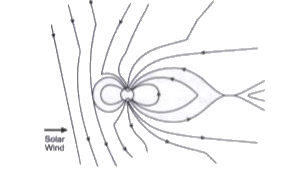
The core of the Earth is an electromagnet. Although the crust is solid, the core of the Earth is surrounded by a mixture of molten iron and nickle. The magnetic field of Earth is caused by currents of electricity that flow in the molten core. These currents are hundreds of miles wide and flow at thousands of miles per hour as the Earth rotates. The powerful magnetic field passes out through the core of the Earth, passes through the crust and enters space. This picture shows the solid inner core region (inner circle) surrounded by a molten outer core (the area between the two circles). The currents flow in the outer core, travel outwards through the rest of the earth's interior. If the Earth rotated faster, it would have a stronger magnetic field.
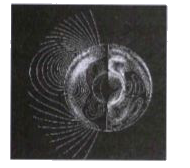
By the time the field has reached the surface of Earth, it has weakened a lot, but it is still strong enough to keep your compass needles pointed towards one of its poles. All magnets have two poles: a North Pole and a South Pole. The magnetic poles of earth are not fixed on the surface, but wander quite a bit. The pole in the Northern Hemisphere seems to be moving northwards in geographic latitude by about 10 kilometres per year by an average.
The Earth's magnetism is due to:Ainduction of Sun's magnetism.Bcurrent produced by the movement of molten metals.Csea current.Drevolution of the Earth round the Sun.Read the following text and answer the following questions on the basis of the same:
If we move into space and study the Earth's invisible magnetic field, it wouldn't really look like a bar magnet at all. Earth's magnetic field gets stretched out into a comet-like shape with a tail of magnetism that stretches millions of miles behind the earth, opposite to the Sun. The Sun has a wind of gas that pushes the earths field from the left to the right in the picture.
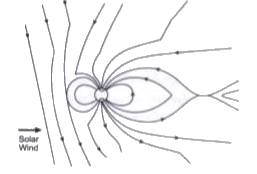
The core of the Earth is an electromagnet. Although the crust is solid, the core of the Earth is surrounded by a mixture of molten iron and nickle. The magnetic field of Earth is caused by currents of electricity that flow in the molten core. These currents are hundreds of miles wide and flow at thousands of miles per hour as the Earth rotates. The powerful magnetic field passes out through the core of the Earth, passes through the crust and enters space. This picture shows the solid inner core region (inner circle) surrounded by a molten outer core (the area between the two circles). The currents flow in the outer core, travel outwards through the rest of the earth's interior. If the Earth rotated faster, it would have a stronger magnetic field.

By the time the field has reached the surface of Earth, it has weakened a lot, but it is still strong enough to keep your compass needles pointed towards one of its poles. All magnets have two poles: a North Pole and a South Pole. The magnetic poles of earth are not fixed on the surface, but wander quite a bit. The pole in the Northern Hemisphere seems to be moving northwards in geographic latitude by about 10 kilometres per year by an average.
The magnetic poles of Earth are:Afixed on the surfaceBwander throughout the Earth's surfaceCwander about 1000 kilometres per year on an average.Dwander about 10 kilometres per year on an average.The earth's magnetic field
Avaries in direction but not in magnitude.Bvaries in magnitude but not in direction.Cvaries both in magnitude and direction.Dremains constant.
